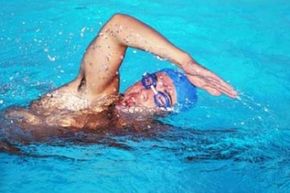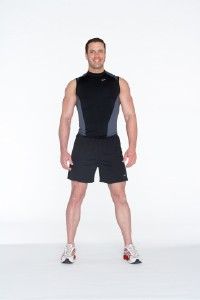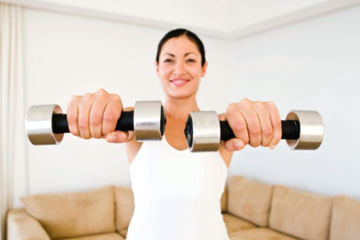Tired of looking in the mirror and not liking what you see? Tired of that flabby midsection you’re carrying around? Tired of feeling tired all the time? You don’t have to be. Following the home workout program detailed in this article, you’ll end up looking good and feeling great. What’s more, you’ll get other benefits you might not have thought about.
Numerous studies indicate that our lifestyle clearly affects our ability to remain healthy and avoid injury. Lifestyle also plays a role in how we look and how we feel about ourselves. Fortunately, we now have more information than ever before about what constitutes a healthy, productive lifestyle.
High on the list of elements is exercise. Regular exercise can help you lose weight, shape up your body, and ward off certain diseases. Research also indicates that getting active and staying active can help boost your self-confidence, reduce stress and anxiety, improve your productivity, and enhance the overall quality of your life.
Sound too good to be true? Exercise is neither a quick fix nor a miracle cure. Like healthy eating habits, exercise needs to become a regular, permanent part of your life in order to work its magic. And you need to put in the effort to make it work for you. That’s where this home workout program comes in. This program gives you what you need to start toning up, slimming down, and taking charge of your lifestyle.
The home workout program includes a comprehensive set of strengthening and toning exercises that can be done in your home without any fancy equipment. The emphasis of the exercises is on the muscles of the abdomen and lower back to help you develop the tight, flat stomach you’ve always longed for.
The home workout program strengthens and tones muscles throughout the body, too. After all, your body works as a unit, and weakness in one area can cause strain and even injury in another. The exercises are designed to help strengthen your muscles and get them into shape — not to build bulk.
Research indicates that exercises that increase muscle strength and endurance can do more than improve your appearance; they can help enhance your performance, increase your lean body mass (the amount of muscle, rather than fat, that you carry around), and reduce injury and discomfort. Indeed, the American College of Sports Medicine added strength training to aerobic exercise in its recommendations for developing and maintaining fitness in healthy adults.
Before you get started sculpting your body, learn a few basics about fitness and toning on the next page.
Contents
- Fitness and Toning
- Exercise Routine
- Muscle Groups
- Warm-up and Cool-down Exercises
- Home Exercises
Fitness and Toning
“
Aerobic exercise, such as swimming, biking or running, will maximize the benefits of a strength training program.
Publications International, Ltd.
Strength training can help you achieve both fitness and toning, although it works best when coupled with other activities.
To achieve strong, taut muscles and cardiovascular fitness, the American College of Sports Medicine recommends that strength training be done two to three times a week and that aerobic exercise be done three to five times a week. The exercises in this program, which have links on the last page of this article, will provide you with a balanced strength-training program that will tone and shape your abdomen and sculpt muscles throughout your body. They’ll burn calories, too, which can help you lose excess body fat while keeping muscle.
But to achieve the greatest health and fitness benefits — and the greatest change in appearance — you’ll need to choose an aerobic activity to supplement your strength training.
The aerobic exercise will help you to further reduce body fat, including the fat you may be wearing around your middle. It will also strengthen your heart and lungs. By combining the slimming effect of aerobic exercise and the toning power of strengthening exercises, you’ll soon be sporting a body that turns heads on the beach.
Aerobic exercise is any rhythmic and continuous movement involving the large muscle groups of the body over an extended period. This includes such activities as walking, running, biking, and swimming.
For a knockout punch against body fat, experts recommend the combination of exercise and proper diet. Your diet should be low in fat and cholesterol and high in complex carbohydrates, such as bread, potatoes, vegetables, cereals, and pasta. It’s also important to select a wide variety of foods to be sure you’re providing your body with the vitamins, minerals, and other nutrients it needs.
Dress comfortably in clothing that promotes movement and heat loss. A T-shirt and shorts are fine. Plastic or rubberized clothing is not recommended. Wear athletic shoes that provide stability and comfort. If possible, work on a wooden floor, carpet, or other surface that gives with the body. For floor exercises, work on a mat or fold a towel and lay it underneath your back to avoid irritation.
Finally, although this program is designed to provide safe, effective exercises for strengthening the muscles, it is recommended that you consult your doctor before beginning the program.
Find out how to get the most out of this program on the next page.
For more great exercises to improve your strength and fitness, check these out:
- Warm-Up Exercises
- Arm, Chest, and Shoulder Exercises
- Leg Exercises
- Stretching
Exercise Routine
The exercise routine in the home workout program is designed to give you a balanced, total-body workout with emphasis on the abdominal muscles. You can do all the exercises in this program in approximately 50 minutes. If you are pressed for time, you can choose one group of exercises, which will allow you to focus on a particular area of the body.
However, the greatest gains will come if you consistently work through the entire program. In any case, you should always begin your workout with the warm-up exercises and end with the stretching exercises. (All the exercises in this program are linked from the last page of this article.)
Try to establish an exercise schedule, alternating the strength training in this article with aerobic exercise. Your schedule might include strengthening exercises on Tuesday and Thursday and aerobic exercise on Monday, Wednesday, and Friday. Try to work up to two to three days of strength training and at least three days of aerobic exercise each week. Make an appointment with yourself to exercise and allow nothing to interfere. Find the time of day that works best for you and stick to it.
If you cannot execute an exercise exactly as described, don’t worry. Try it and do the best that you can do. Work at your own comfort level. Over time, your strength and flexibility will improve and so will your exercise performance.
As you become more familiar with the exercises themselves, strive to move smoothly from one exercise to the next. Working out to music can help you set a pace and keep you moving from exercise to exercise.
If you feel a little sore or stiff during your first few days on the program, that’s normal. Treat yourself to a massage or relaxing bath. When you get in better condition, the stiffness and soreness will diminish. Remember to complete the cool-down, too, since it will help reduce soreness.
Keep yourself well hydrated whenever you exercise. Pour a glass of water at the start of your exercise routine and keep it by your side. Take short sips about every ten minutes. Don’t wait until you get thirsty. Becoming dehydrated will make you feel fatigued and discouraged. Stay strong and positive.
The aerobic exercise sessions should last between 20 and 60 minutes each, depending on how hard you work and what your goals are.
To get aerobic benefits, fitness specialists advise that you exercise at 60 to 90 percent of your maximum heart rate. You can determine your training heart rate zone by consulting a medical or exercise professional. You can also estimate it on your own. Begin by subtracting your age from the number 220; this will give you your maximum heart rate per minute. For example, if you’re 30 years old, your maximum heart rate is about 190 (220-30) beats per minute.
Once you know your maximum heart rate, multiply it by .6 (60 percent) and .9 (90 percent) respectively to find the lower and upper limits of your training zone. For example, if your maximum heart rate is 190 beats per minute, your training zone is between 114 (190 x .6) and 171 (190 x .9) beats per minute. If you are just starting out with an exercise program, exercise toward the low end of your training zone and gradually increase exercise intensity. For a fat-burning aerobic workout, longer (30 minutes or more) and more frequent (four or five days a week) workouts at a more moderate pace are recommended.
To check your heart rate, you need a watch that measures seconds. You can take your pulse either at the radial artery in your wrist (on the inner side of your wrist, below the heel of your hand) or at the carotid artery in your neck (next to your Adam’s apple). Place the index and middle fingers of one hand gently on either spot to feel the pulse. Count the number of beats for ten seconds, then multiply by six to determine your heart rate in beats per minute.
By briefly checking your pulse during aerobic exercise, you’ll be able to tell if you’re working in your target zone. If your heart rate is below the target zone, increase your pace. If it’s above, slow down. Also, be sure to read the Warm-Up and Cool-Down Exercises page, as those exercises are important for both strengthening and aerobic workouts.
The program is designed to work a wide variety of muscle groups. Find out what those groups are, and what they do, on the next page.
For more great exercises to improve your strength and fitness, check these out:
- Warm-Up Exercises
- Arm, Chest, and Shoulder Exercises
- Leg Exercises
- Stretching
Muscle Groups
“
You’ll want to exercise a wide range of muscle groups.
Publications International, Ltd.
If you perform all the home exercises in this program, you will be working muscle groups throughout the body, in addition to the abdominals. Among the muscles that will get a workout:
- Calf muscle: Located at the back of the lower leg, the calf muscle, or gastrocnemius, helps in bending the leg at the knee and extending the foot.
- Quadriceps: Located at the front of the thigh, the four muscles that make up the quadriceps are responsible for extending the leg at the knee.
- Hamstring: Located at the back of the thigh, the three muscles that make up the hamstring extend the leg at the hip and bend the leg at the knee.
- Hip flexors: Located at the top of the front part of the thigh, these muscles bend the leg at the hip and help to bend the lower spine.
- Outer thigh: The three muscles located at the side of the hip and leg are known as the abductor muscle group. They are responsible for lifting the leg out to the side.
- Inner thigh: The muscles located at the inner side of the thigh are called the adductor muscle group. They are responsible for pulling the legs together.
- Gluteals: The gluteals, or muscles of the buttocks, are responsible for extending and rotating the thigh at the hip and moving the thigh back behind the body.
- Biceps: Located at the front of the upper arm, the two muscles that make up the biceps are responsible for flexing, or bending, the arm at the elbow.
- Triceps: Located at the back of the arm, the three muscles that make up the triceps are responsible for extending or straightening, the arm at the elbow.
- Deltoids: These muscles at the shoulder lift the arm from the shoulder to the front, side, and back.
- Pectorals: Located at the front of the chest, these muscles are responsible for pulling the arms together from the shoulder joints.
To work these muscles most efficiently, you’ll want to warm up before and cool down after exercising. Learn the principles of warming up and cooling down on the next page.
For more great exercises to improve your strength and fitness, check these out:
- Warm-Up Exercises
- Arm, Chest, and Shoulder Exercises
- Leg Exercises
- Stretching
Warm-up and Cool-down Exercises
“
Warm-up and cool-down exercises help prepare muscles for a more intense workout.
Publications International, Ltd.
Warm-up and cool-down exercises, or stretching, are essential to any exercise program. The warm-up prepares your body for exercise and plays an important role in helping to prevent injury. Also, it mentally prepares and motivates you for the workout to come.
Before beginning every exercise session, do an eight- to ten-minute warm-up. The warm-up exercises for the home workout program, which are linked from the last page of this article, provide a great rhythmic limbering warm-up for the strengthening exercises in this program. (For aerobic exercise sessions, this warm-up should be supplemented with mild, static stretches that stretch the muscles you’ll be using. If you plan to walk or jog, for example, lower body stretches would be appropriate.)
The warm-up should be intense enough to increase your body temperature but not strenuous enough to cause fatigue. A rule of thumb might be to work hard enough to break a mild sweat, although room temperature and humidity can affect this.
Every exercise session should also be followed by a cool-down that gradually decreases your heart rate and stretches all the muscles worked in the exercise session.
During the cool-down, stretching has the greatest potential to increase your range of motion and enhance your overall flexibility, because the muscles are warm and thus more pliable. "Cool-down" provides the balanced cool-down you’ll need for the exercises in this program. (As a cool-down for your aerobic exercise, first slow the pace of your activity for a few minutes, then top off the workout with stretching.)
Stretch down the length of the muscle, especially in the lower leg and back area, which are often tight. Stretch to a point of slight tension, never pain. Keep your joints in alignment and follow the guidelines for proper exercise form during both the warm-up and cool-down. Stretch slowly and gently. Bouncing or stretching too fast can lead to muscle and tendon injuries. Gentle, slow stretching, on the other hand, will actually help prevent injury and decrease muscle soreness. Stretching slowly also gives you time to relax and concentrate on your exercise form, and it allows you to unwind psychologically.
Inhale as you get into your stretch position, then exhale as you relax into the stretch. Exhaling as you relax into the stretch allows you to further lengthen the connective tissue-as tension is released, the stretch increases. Hold each stretch for 30 to 60 seconds. Concentrate on how you feel throughout these movements.
A BODY IN MOTION STAYS IN MOTION! So, pour yourself a glass of water, play your favorite music, and get moving! Use the links on the next page to learn all the exercises in this program.
For more great exercises to improve your strength and fitness, check these out:
- Warm-Up Exercises
- Arm, Chest, and Shoulder Exercises
- Leg Exercises
- Stretching
Home Exercises
The following home exercises represent a full range of workout activities. They entail warm-up exercises that prepare your muscles for more intense activity and help prevent injury. The arm, chest, and shoulder exercises emphasize biceps and triceps, among other muscle groups. The abdominal exercises strengthen the core muscles of the body, trimming your waist and improving posture. Leg exercises strengthen the muscles that allow you to run, jump, and climb stairs; these include the thighs, hip flexors, and quadriceps.
Finally, stretches should be performed every time you conclude your exercise routine. Stretching can help prevent typical muscle soreness after a workout and acts as a cool down for the muscles. The following program of home exercises will benefit your overall fitness and strengthen your muscles, slimming your physique and improving your health.
- Warm-Up Exercises
- Arm, Chest, and Shoulder Exercises
- Leg Exercises
- Stretching
A home workout can be done at any time, without having to add time traveling to the gym or waiting for equipment. Use the exercises in this article and you’ll be on your way to a toned, fit body from the comfort of your home.
ABOUT THE AUTHOR
Lisa Faremouth is a fitness specialist who is a certified exercise instructor and member of the American Council on Exercise and the Aerobic Fitness Association of America. She was awarded a silver medal in the Reebok National Aerobic 1989 Championships for the Midwest region and has served as director of exercise programs for a large health club in Chicago. Through her company, Fitfully Yours, she provides education, consultation, training, and workshops to fitness centers, corporations, and individuals worldwide.




